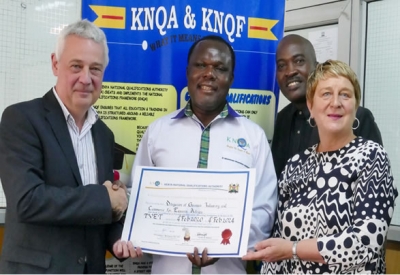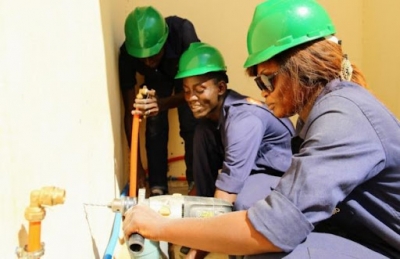Technical and vocational education and training (TVET) provides requisite skills for employment and plays an integral part in equipping young people and adults, with necessary expertise to afford them decent employment, better livelihoods and improved social economic status. The issue of skills development and inclusivity is taking centre stage in most social economic conversations globally, especially when we consider the potential contribution towards achievements of sustainable development.
Kenya Institute of Special Education in conjunction with the Ministry of Education between September 2016 and June 2017 conducted a national survey on children with disabilities and special needs in Kenya. The findings from this survey indicated that “the prevalence rate of children with special needs and disabilities aged between 3 and 21 years in Kenya was 11.4%. There was a relatively even distribution of disabilities among male and female children where 51.2% were males and 48.8% were females and that 72.6% of them live in rural areas while 27.4% live in urban areas. A significant number of these children are enrolled in schools however with a high dropout rate.”
Looking at these statistics further, we find that the number of students living with disabilities transitioning to tertiary institutions drastically reduces with only 2% of them enrolled in TVET institutions where about 7 % have mental or intellectual disabilities. This has been attributed to systemic discrimination resulting in low numbers because of a variety of reasons.
Exclusion and barriers to access
In delving a little deeper, we look at the reasons for exclusion at tertiary education level. Social perceptions and stereotypes seem to top the reasons, right from the formative years in school. Throughout their education journey there will be other reasons that will cause people with disabilities (PWDs) to either drop out of school and at tertiary level select courses according to stereotypes assigned to them which sometimes also affects their choice of institution of learning. Other situations that will affect their education and transition along the different levels of education will include infrastructural challenges brought about by designs which may hinder access, means of transport, lack of support from the family, negative social cultural beliefs, inability to acquire devices especially those with sensory disabilities, gaps in the curriculum and trainers who may not understand how to deal with PWD’s.
Unfortunately this discrimination normally extends to the workplace where majority of persons with disabilities in Kenya are largely employed in the informal sector as the formal sector does not have enough jobs for them or may not be willing to accommodate their disabilities because they do not understand them. Access to formal employment normally will depend on different situations such as the type of disability or level of education and interestingly sometimes roles are prescribed again according to the stereotype assigned to the type of disability.
What is needed to alleviate these challenges?
Raising awareness on disability inclusion while addressing negative attitudes, stereotypes and stigma will drive change, create equal and fair opportunities for everyone. The systemic barriers that emanate from social cultural and institutional discrimination can be tackled from increased awareness and appreciation of different abilities of an inclusive society.
Impressing upon policy makers and educationists to fast track policies on inclusion will allow for appreciation of the challenges faced by PWD’s ensuring a favourable training environment for them. The push for development, legislation and implementation of policies on inclusive education will enhance access, retention and transition of children with disabilities and special needs. These policies are also expected to influence consideration for appropriate infrastructure designs during construction and even renovations in education institutions that will accommodate PWD’s making them feel included. Legislation on career guidance in TVET institutions should be implemented especially in career counseling of PWD’s to help them make informed career choices as they pursue their tertiary education. The Career offices set up in these institutions should provide these services to the students when they enroll in college especially if they did not get the chance to access career guidance in high school.
Together with the above interventions, ensuring accessibility and affordability will improve the chances of staying in class and eventually graduating from college. This goes hand in hand with PWD’s having access to scholarships which gives them a chance to enroll in college and complete their tertiary education. Capacity building and support of trainers in TVET institutions is likely to enhance their role as knowledge providers to the students giving them confidence in the delivery of inclusive education.
Preparing PWD’s for transition into the labour market is incumbent on collaboration between TVET institutions and industry. Effective early engagement between Industry and TVET institutions is encouraged to create a structured system of internship, apprenticeships and employment therefore improving students’ labour market prospects.
Finally, being cognizant of all the efforts being employed to address inclusion provides the impetus to keep pushing for interventions that will make the implementation of inclusivity a possibility. Many initiatives sometimes suffer from challenges of sustainability because of lack of a monitoring and evaluation (M & E) system that has clear deliverables to measure success and challenges in implementation of many interventions. Deploying M& E should also be considered as part of accountability and sustainability of inclusive education.
In conclusion, embracing inclusivity will provide opportunities that promote positive outcomes, embrace diversity and encourage young people to aspire for education and employment when barriers to learning are removed. Partnerships are important in conjuring commitment from stakeholders who will champion inclusive tertiary education in the communities, in training institutions and the workplace. A well-defined inclusive program can result in improved education and labour market outcomes and the well-being of these vulnerable young people who will have a purpose and who will contribute to nation building.
Priscilla Kerebi, Publisher Edsource





